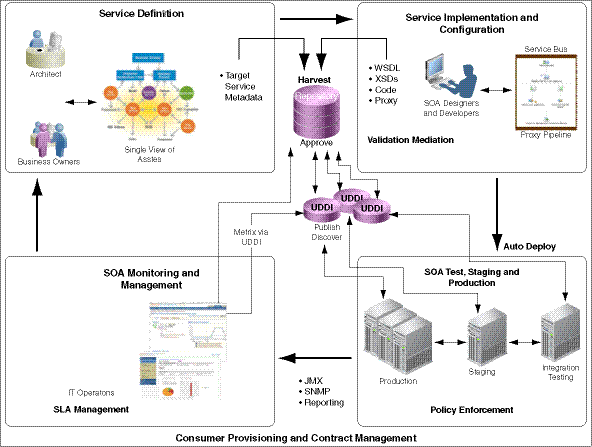4 Stakeholder Identity
This chapter describes who stakeholders are, their typical duties, and how to assign roles to them in Oracle Enterprise Repository.
This chapter contains the following sections:
4.1 Overview
After identifying governed assets, you work with stakeholders to:
-
Determine how they can best leverage Oracle Enterprise Repository
-
Identify additional metadata required
-
Modify taxonomies and categorizations
-
Customize their access and asset views
Figure 4-1 Closed Loop Governance Process

Description of "Figure 4-1 Closed Loop Governance Process"
Figure 4-1 shows stakeholder participation in and infrastructure of the closed loop governance process.
-
For information about establishing Users in Oracle Enterprise Repository, see "Users" in Oracle Fusion Middleware Configuration Guide for Oracle Enterprise Repository.
-
For information about assigning Roles to Users, see "Roles" and "Access Settings" in Oracle Fusion Middleware Configuration Guide for Oracle Enterprise Repository.
-
For more information about Governance structures and best-of-breed Governance solutions, see the OFRA Governance material at
http://www.oracle.com/technology/products/soa/repository/index.html
4.2 Stakeholders
This section describes the Oracle Enterprise Repository stakeholders:
4.2.1 Service Competency Center, Software Factory, or Portfolio Management Team
-
Identify common needs across the community
-
Identify assets and levels of investment needed to fulfill those needs
-
Determine the expected return on asset investments
-
Manage the asset lifecycle, including inception, creation, distribution, usage, and retirement
-
Define common functionality in the Enterprise Repository
-
Create an asset in Oracle Enterprise Repository
-
Populate definitional metadata
-
Attach relevant documentation
-
Identify a target availability date
-
-
Establish Governance workflows for their asset portfolio
For more information about workflows, see "Configuring Oracle Enterprise Repository Workflow" in Oracle Fusion Middleware Configuration Guide for Oracle Enterprise Repository
-
Participate in the Governance approval process for assets in their portfolio.
-
Evaluate asset performance by reviewing usage history, developer feedback, runtime performance metrics, policy status, and compliance reports
-
Use the Oracle Enterprise Repository Navigator to evaluate the impact asset modification
-
Create new versions of existing assets, and retire old versions
Typical Roles Assigned in Oracle Enterprise Repository
Registrar
4.2.2 Business Analysts
-
Specify global business requirements
-
Reuse existing business processes
-
Structure new business processes using existing capabilities and services
-
Drive revenue by extending business processes to trading partners
Typical Roles Assigned in Oracle Enterprise Repository
Advanced Submitter
4.2.3 Project Architects
-
Analyze software assets for maximum reuse in architecture design (Service Level Agreements for services, maturity of components, design document)
-
Create and use applications, services, and component versions
-
Notify stakeholders of changes to applications, services, and components
Typical Roles Assigned in Oracle Enterprise Repository
Advanced Submitter
4.2.4 Developers (as Consumers)
-
Analyze software assets for specific reuse (features, dependencies, how to guides, test harness)
-
Use applications, services, and component versions
-
Notify stakeholders of changes to applications, services, and components
-
Use reusable assets when creating other assets
-
Search the repository for suitable reusable assets for projects
-
Integrate reusable assets and make any necessary modifications
Typical Roles Assigned in Oracle Enterprise Repository
User
4.2.5 Developers (as Producers or Harvesters)
-
Create reusable assets from the beginning or reengineer existing assets to be reusable
-
Test assets and ensure quality standards
-
Maintain assets
-
Help users understand asset functionality, features, limitations, and applicability
Typical Roles Assigned in Oracle Enterprise Repository
Advanced Submitter
4.2.6 Registrars
-
Assess, certify, classify, add, and delete assets
-
Maintain operational aspects of the repository
-
Ensure that work products meet quality, documentation, and other established standards
-
Communicate new work product additions or deletions to all constituents
-
Match consumer engineer needs with producer engineer capabilities and availability
Typical Roles Assigned in Oracle Enterprise Repository
Registrar
4.2.7 Enterprise Architects
-
Track progress toward the target architecture
-
Communicate progress to the executives
-
Communicate architectural standards to delivery teams
-
Monitor compliance
Typical Roles Assigned in Oracle Enterprise Repository
Registrar
4.2.8 Program Managers
-
Coordinate planning, prioritization, monitoring, and support of the governance program, while aligning it with changing business needs
-
Facilitate the definition of the program objectives
-
Oversee the enterprise initiative
-
Establish consensus and promote the program goals and objectives, including schedules, budget, key milestones, and deliverables
-
Co-develop, review, and integrate the supporting project plans
-
Develop communication plans, risk management plans, and skill gap analysis
-
Provide regular updates to senior management, customer representatives, and program participants
-
Establish metrics and reporting requirements
Typical Roles Assigned in Oracle Enterprise Repository
Registrar Administrator
4.2.9 CIO
Analyze use and reuse of applications, components, and services by LOB, product, and value chain
Typical Roles Assigned in Oracle Enterprise Repository
User
4.2.10 Executive Sponsor
-
Represents management interests
-
Authorizes, encourages, and supports resource use
-
Shows that management supports the program
Typical Roles Assigned in Oracle Enterprise Repository
User
4.2.11 Governance Champion
-
Supports the program through organization-wide evangelism
-
Educates others on program concepts, long-term benefits, inhibitors, and purpose
-
Sets implementation direction
-
Communicates successful efforts throughout the organization
Typical Roles Assigned in Oracle Enterprise Repository
User